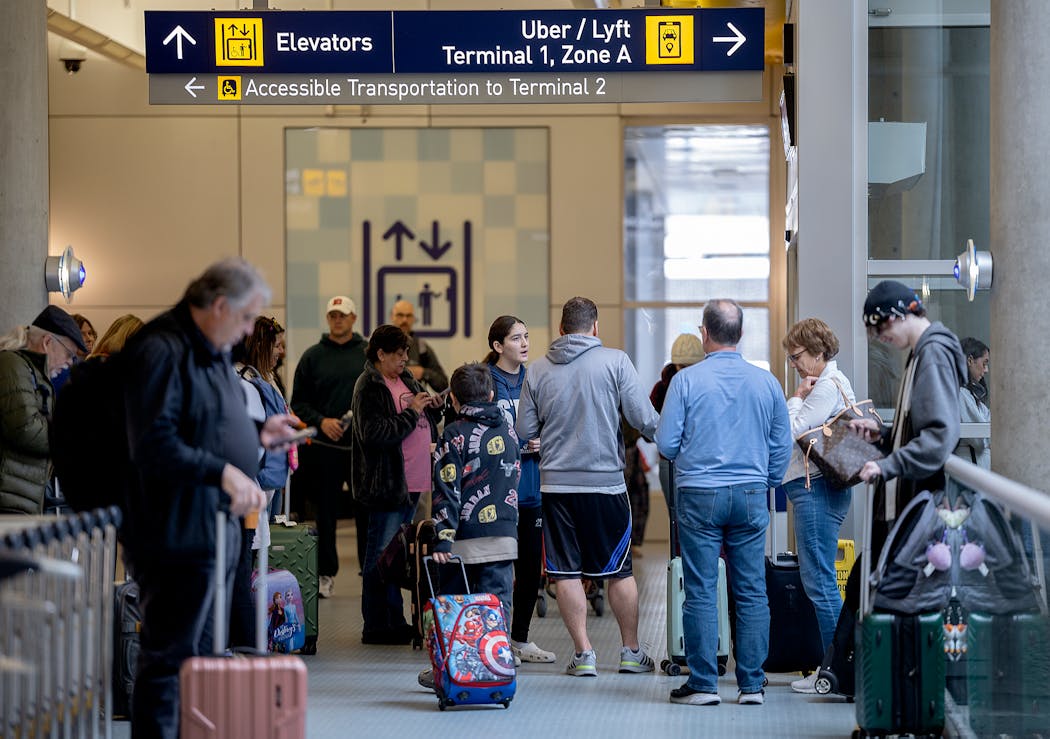Fresh off a plane from Detroit for a business trip, Ray Bryant glanced frequently at his phone while waiting for an Uber at Minneapolis-St. Paul International Airport last week. When asked about the possibility of Uber leaving the Twin Cities market due to a labor dispute, his response was swift.
"That would be bad," he said.
Bryant was one of the nearly 3,000 ridesharing requests originating from Terminal 1 every day, as Uber and Lyft service have largely replaced the taxi industry at MSP since their debut eight years ago.
Those arriving and departing from MSP would be among the hardest hit in Minnesota should the San Francisco-based ridesharing service depart on May 1. Its rival Lyft has said it will continue service at the airport but wouldn't ferry customers to Minneapolis, the biggest city in the state.
The threat comes after the Minneapolis City Council adopted an ordinance earlier this month setting minimum pay requirements for rideshare drivers at an amount both Uber and Lyft say is too high. Faced with blowback, the council may now revise the ordinance, although it's unclear whether it will be to the ridesharing giants' liking.
Officials at the Metropolitan Airports Commission (MAC), which runs the airport, find the prospect of an imminent departure deeply unsettling. "Thousands of people rely on ridesharing services to and from the airport every day," said MAC Chair Rick King. "We are concerned if these services are curtailed. We are hopeful for a positive resolution."
Of the 18 million rides provided by Uber and Lyft to Minnesota passengers in 2022, nearly 3 million started or ended at MSP, according to a report prepared by two economists for the Minnesota Department of Labor and Industry.
"Both Uber and Lyft are woven into city life like running water, electricity and Wi-Fi," said Henry Harteveldt, a San Francisco-based travel industry analyst. "We expect them to be available to us." And if they're not, "it could have a real impact on the way people view the Twin Cities."
Ironically, the airport just opened a new $1.2 million Ground Transportation Center in December. Located on the first level of the Green and Gold parking ramps of the main terminal, the new facility will accommodate double the number of ridesharing vehicles, regional and hotel shuttles, limousines, and taxis.
When MAC officials adopted new rules for ridesharing companies in 2016, the emotional public hearings pitted Uber and Lyft drivers who represented the emerging gig economy against taxi operators.
As it turned out, ridesharing firms emerged to dominate the airport transportation market. Currently, there are 6,950 Uber permits and 5,361 Lyft permits registered with the MAC, compared to 244 for taxicabs.
Ridesharing has emerged as a steady and growing source of revenue for the MAC, which collected about $9.7 million from operators last year.
If ridesharing services disappear or decline at MSP, people could park in one of nine parking ramps at both terminals. But demand fluctuates at these facilities — on Thursday as spring break began in earnest, parking ramps at Terminals 1 and 2 were more than 75% full, and the cheapest daily rate at the value parking ramp was $23.
Public transportation also serves the airport, including the Blue Line light rail, Metro Transit's Route 54 bus, and Minnesota Valley Transit Authority and Southwest Transit buses from the suburbs.
On Wednesday afternoon, before spring break travelers and a snowstorm descended on MSP, the Ground Transportation Center was busy mostly with ridesharing customers staring anxiously at phones and approaching vehicles.
If Uber leaves, "it will make it more inconvenient," said Minneapolis resident Michael Nicholls, while waiting for his ride. "Uber makes everything very convenient, although I'm a huge advocate for public transit. If they leave, we will adapt."

In Grand Rapids, Itasca Pride is planning its first event, but there is already pushback
One person shot at YMCA in Coon Rapids

BCA says man pointed pistol-style BB gun at officers before he was shot in Woodbury

Former diversity worker sues University of Minnesota after firing over swastika photo



